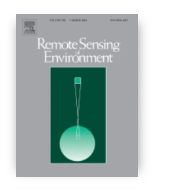Long-term ice mass changes in Greenland and Antarctica derived from satellite laser ranging
Filip Gałdyn; Krzysztof Sośnica; Radosław Zajdel; Ulrich Meyer; Adrian Jäggi
Remote Sensing of Environment
Ministerial score = 200.0
Journal Impact Factor (2023) = 13.5 (Q1)
 Time-variable gravity field models obtained from satellite gravimetric techniques allow for the assessment of ice sheet mass changes in remote polar regions, such as Greenland and Antarctica. So far, GRACE has been the primary mission for obtaining the global time-variable gravity field models. However, GRACE was launched in 2002, thus very little is known about the global mass changes before this data, as well as between GRACE and its successor – GRACE Follow-On. We derive a method of gravity field recovery based on Satellite Laser Ranging (SLR) data to geodetic satellites that allows for obtaining direct ice mass change estimates for a period longer by 10 years than that provided by the GRACE missions. The developed method is based on splitting normal equation systems and re-stacking the solutions which allow for stable inversion, reduces the correlations between obtained parameters, stabilizes the ice mass estimates in polar regions, and reduces the noise over oceans by a factor of four. The secular trends obtained from SLR are equal to −113.5 and −82.8 Gt/year, whereas these are −119.1 and −83.3 Gt/year from GRACE and GRACE-FO to degree and order 10 for Greenland and West Antarctica, respectively, for the common period of 2002–2021 and after removing the post-glacial rebound effect. Despite the conformity of the trend and patterns, an underestimation is observed in the solutions expanded to degree and order 10. Therefore, scaling factors between GRACE/GRACE-FO expanded up to a degree and order 10 × 10 and 60 × 60 were derived and applied to SLR solutions to account for the differences in mass estimates due to the truncation of the models. SLR data revealed that in Greenland the smallest ice mass trends are for 1995–2000, 2000–2005, and 2015–2020 which are equal to +54.3, −15.5, and −75.9 Gt/year. The largest ice mass depletion periods took place in 2005–2010, 2010–2015, and recently in 2019–2021 with trends of −213.9, −287.2, and −276.1 Gt/year, respectively. For Greenland and West Antarctica, the period 2010–2015 is characterized by the most enormous ice depletion events, whereas the later 5-year period of 2015–2020 provided a near mass-equilibrium for Antarctica reducing the negative trend and returning to the situation from the ‘90s when no significant ice mass changes were observed.
Time-variable gravity field models obtained from satellite gravimetric techniques allow for the assessment of ice sheet mass changes in remote polar regions, such as Greenland and Antarctica. So far, GRACE has been the primary mission for obtaining the global time-variable gravity field models. However, GRACE was launched in 2002, thus very little is known about the global mass changes before this data, as well as between GRACE and its successor – GRACE Follow-On. We derive a method of gravity field recovery based on Satellite Laser Ranging (SLR) data to geodetic satellites that allows for obtaining direct ice mass change estimates for a period longer by 10 years than that provided by the GRACE missions. The developed method is based on splitting normal equation systems and re-stacking the solutions which allow for stable inversion, reduces the correlations between obtained parameters, stabilizes the ice mass estimates in polar regions, and reduces the noise over oceans by a factor of four. The secular trends obtained from SLR are equal to −113.5 and −82.8 Gt/year, whereas these are −119.1 and −83.3 Gt/year from GRACE and GRACE-FO to degree and order 10 for Greenland and West Antarctica, respectively, for the common period of 2002–2021 and after removing the post-glacial rebound effect. Despite the conformity of the trend and patterns, an underestimation is observed in the solutions expanded to degree and order 10. Therefore, scaling factors between GRACE/GRACE-FO expanded up to a degree and order 10 × 10 and 60 × 60 were derived and applied to SLR solutions to account for the differences in mass estimates due to the truncation of the models. SLR data revealed that in Greenland the smallest ice mass trends are for 1995–2000, 2000–2005, and 2015–2020 which are equal to +54.3, −15.5, and −75.9 Gt/year. The largest ice mass depletion periods took place in 2005–2010, 2010–2015, and recently in 2019–2021 with trends of −213.9, −287.2, and −276.1 Gt/year, respectively. For Greenland and West Antarctica, the period 2010–2015 is characterized by the most enormous ice depletion events, whereas the later 5-year period of 2015–2020 provided a near mass-equilibrium for Antarctica reducing the negative trend and returning to the situation from the ‘90s when no significant ice mass changes were observed.
DOI:10.1016/j.rse.2024.113994









